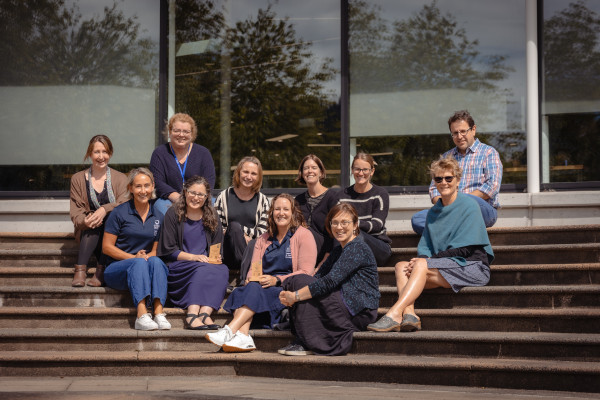- Tūhono home Hoki ki Tūhono
-
- Staff Directory
- Chief Executive Office Auckland International Office Corporate Services Finance Campus Services Functions and Catering Information Systems and Support Marketing, Communications and Engagement Learner Journey Academic Registry International Learner Services Te Punaka Ōwheo
- Learner Experience Academic Excellence Central Campus College of Community Development and Personal Wellbeing College of Engineering, Construction and Living Sciences College of Health College of Work Based Learning Open Education Resource/OERu Research and Postgraduate Studies Te Maru Pumanawa | College of Creative Practice and Enterprise
- Māori Development and Kaitohutohu Office People, Culture & Safety People and Culture Childcare Centre Te Ama Ako | Learning and Teaching Development Wellbeing and Safety Auckland Staff Directory Executive Office Academic Corporate Services Marketing and Business Development Human Resources Campus Quality and Programme Development
-
 Our people make a better world
Our people make a better world
We build the capabilities of individuals, organisations and communities and help them to realise their potential.
Staff Directory
-
- Tools
- Academic Integrity Declaration Form AIC Applications Dashboard Approved Programmes Approved Programme Fees Centralised Assessement Repository Chemwatch CMS - Tūhono & StudentHub updates Course Evaluation and Surveys CRM Applications CRM customer service hub Delegations policy/process Disability and Neurodiversity Dynamics 365 (CRM) EBS Ontrack EBS Report Email Security Personal Portal Employment Matters / Solarworkplace eTaxi eTV
- Financial Variance Reporting Hidden Disabilities Sunflower programme FCM travel intranet InPlace International entry requirements Knowledgebase articles Learner Capability Learner Support Dashboards Linkedin Learning Log a job with Marketing Login as an applicant Microsoft 365 Moderation App Moodle OP Docs OP Docs - Publishing OP Image Libraries Performance Excellence Portal Product Evaluation Panel
- Policy Library Privacy Programme and Course Design and Development Qualtrics XM RDS Remote Access Support Portal Research Database Robertson Library Staff FAQs about Graduation Status of Programmes Student Hub (Kāpehu demonstration view) Study Abroad info for learners Te Whare (Te Pūkenga intranet) Tūhauora I Wellbeing resources Uniprint Vault Webexpenses Auckland Tools
-
 Vault
Had an accident or near miss?
Log it here
Vault
Had an accident or near miss?
Log it here
-
- Communities
- Community AI Steering Committee Ally Network EBS Community of Interest EdTech Champions Health & Wellbeing Research Internal Evaluation Neurodiversity Professional Team Professoriate Proud@OP Student Support Website Advisory Group Web Champions Working under the Rainbow Project Learner Capability Trade Training Centre
- Committee Academic Committee Animals@OP Diversity and Equity Doctor of Professional Practice Committee Kaunihera Whakahaere - Leadership Council Internal Evaluation Learning & Teaching Leadership Team Library Committee Mental Health and Wellbeing Advisory Group Otago Polytechnic Board of Directors Pastoral Care Code Committee Programme Approvals Committee Research and Postgraduate Committee Research Ethics Committee Staff Subcommittee
- Think Tanks Mātauraka Our learners achieve educational success Pūtea Our financial success Tākata Our people, our team, our community Tiriti Our active commitment as a Treaty partner Tūroa Our commitment to be a sustainable and responsive organisation
-
 Create a community
Create a community
Do you have a community, committee or project that you'd like represented here?
Communities
-
- About OP
- Keep up to date All news All events All notices All blogs Share your info Create a news article Create an event Create a notice Create a blog
- Community and Partnerships Alumni and friends Education Foundation Operational information Academic calendar 2025 Academic calendar 2026 Current vacancies Dunedin campus map Our policies Te Whare (Te Pūkenga intranet) Topical FAQs
- Who we are Commemorative sites Māori Strategic Framework Our history Our strategic priorities Pasifika Strategic Framework (2025-2030) Vision and Values Working for us OP job opportunities Wellbeing Calendar Working at OP
-
New Zealand: 0800 762 786
contact us
International: +64 3 477 3014
Project managers in Scrum Teams: Software development conditions influencing the relative presence of a project manager within Agile Scrum Teams in Oceania and Southeast Asia
Author: Mickail Lim
Supervisors: Lorraine Skelton Farhad Mehdipour
Project managers in Scrum Teams: Software development conditions influencing the relative presence of a project manager within Agile Scrum Teams in Oceania and Southeast Asia
Mickail Joseph Lim
20 July 2021
Lim, M. J. (2021). Project Managers in Scrum Teams: Software Development Conditions Influencing the Relative Presence of a Project Manager within Agile Scrum Teams in Oceania and Southeast Asia. (A thesis submitted in partial fulfilment of the degree of Master of Applied Management at Auckland International Campus, Otago Polytechnic). https://doi.org/10.34074/thes.5493
Abstract
Software development and design are known to be the workhorse of a growing ICT industry. There are many software development project management models that have risen over the past 50 years. These were initially controlled by a Project Manager, who is the central figure for software development using earlier delivery models. Currently, none of these software delivery approaches are more popular than Agile delivery, specifically the Scrum Framework.
The Scrum Framework prescribes that management is owned by the entire team and has done away with the Project Manager role. However, Project Managers still exist within Scrum in industry practice. As such, it is in the interest of this study to explore actual project conditions that would influence the need for a Project Manager in a framework that was designed to do without one. Secondly, this study intends to find out if the perception of success is affected by the presence of a Project Manager in the Scrum Team. At the time of this writing, no such empirical investigation has been done world-wide.
There have been many studies looking at Agile practice and Scrum environments around the world, however, none has done so with a high focus on the Asia-Pacific Region. Therefore, this study will focus on this region, specifically within Oceania and Southeast Asia. A quantitative approach was selected, participant criterion was set, and a database search of LinkedIn was conducted. Among over 9000 results, 1500 randomised samples were determined and contacted to participate in an online survey. Of these, 938 users responded and expressed their interest to participate. Ultimately, 584 survey samples were collected and underwent analysis.
The study confirmed that a significant number of Scrum Teams (almost half of the survey population) still had Project Managers. It was found that a team member's Scrum experience, mixing Scrum with a traditional project management approach, and projects that work on existing software are conditions that statistically affected the presence of a Project Manager in the Scrum Team. On the other hand, the length of the project, team size, the geographical distribution of the team members, and even having multiple Scrum Teams collaborate on a single project had no influence whatsoever on the Project Manager's presence in the team. Furthermore, the study found that a Project Manager’s presence negatively influenced a Scrum Team member’s perception of success.
The study was restricted to an online environment due to its scope and border closures because of a global pandemic. Furthermore, the purely quantitative approach limited contextual insight from the findings. It is recommended that further study be carried out to build on the exploratory data found, such as why a significant portion of the respondents are reporting large Scrum Team sizes, and the significant findings of the study, as discussed above. It also merits further investigation to determine why a Scrum Team member’s perception of success is lower when a Project Manager is present, ideally using a systematic metric for success and failure.
Keywords: project management, project manager, Agile, Waterfall, Scrum, software delivery
Mickail's thesis was supervised by Lorraine Skelton and Farhad Mehdipour.
License
This thesis is available under Creative Commons Attribution-NonCommercial-NoDerivatives licence CC BY-NC-ND 4.0 International.
![]()